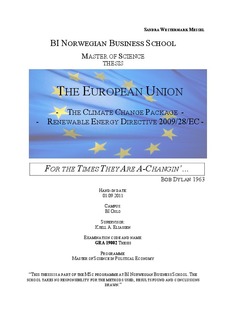| dc.description.abstract | The following general problem for discussion has been chosen: Why did the EU decide on targets concerning renewable energy sources and why exactly these targets? What are the European Union and the nation-states doing to reach these targets, during the implementation process, and is it possible to say something about the level of achievement at this point? The European Union is at a threshold concerning their future energy policy. If the electricity grids are not upgraded, obsolete plant not replaced by competitive and cleaner alternatives and energy is used more efficiently throughout the whole energy chain; competitiveness, security of supply and climate objectives will be undermined. The renewable energy directive sets the targets to be reached by 2020, including a target of 20% renewable energy sources. Each Member States target is calculated starting with their exit level in 2005, adding a flat increase to all the Member States of 5.5%, and then adding an additional increase based on the country’s GDP decided upon the individual targets. Together the Member States expect to more than double their total renewable energy consumption. The share of RES in electricity consumption is predicted to increase to 34.3% in 2020, wind energy and hydropower being the largest contributors. Renewable heating and cooling should reach 22.2% in 2020, with biomass being by far the largest contributor. The share of renewables in transport is forecast to reach 11.27% of diesel and petrol consumption. Only two countries have reported the need of the cooperation mechanisms, in order to reach their goal. Half of the Member States predicts surpassing their binding targets, and the rest foresee they will reach the target. The Netherlands has a goal of 14% reached by 2020, while Sweden’s goal is 49%. The Dutch government does not predict to surpass their goal, although indications points to 15.5%, not yet confirmed. Sweden predicts to reach 50.2%. The Swedish NREAP splits its target into 62.9% RES-E, 62.2% RES-H and 13.8% RES-T. The Dutch NREAPs splits the overall target in the following way: RES-E 37%, RES-H 8.7% and RES-T 10.3%. The targets for 2010 were not met, nor were the targets binding either. The year 2020 will be the key year for measuring the Unions effort. Several actors (e.g. EREC 2011) emphasize largely how the EU could have set even more ambitious targets, and reaching them. Estimations from the industry suggest 24.4%. | no_NO |
